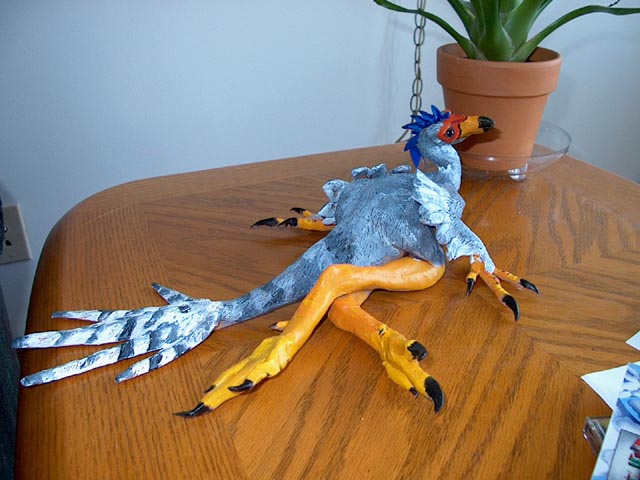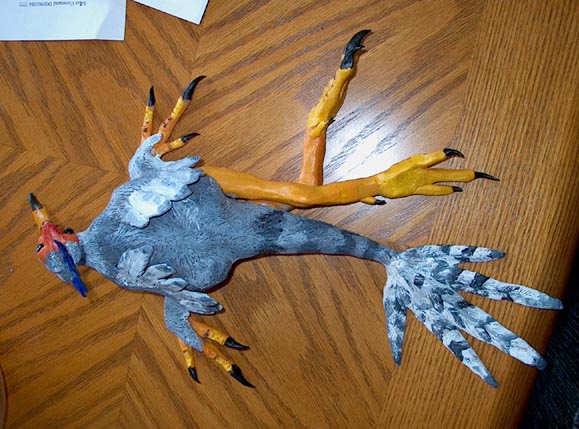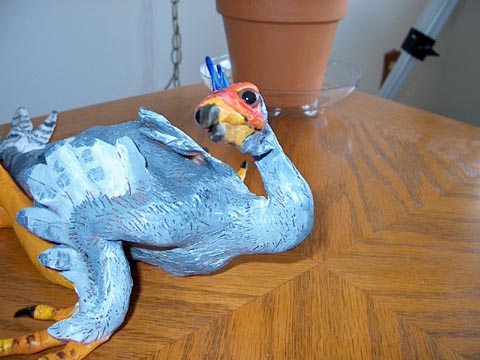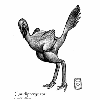
Caudipteryx: Super sculpty, Acrylic paint.
A great deal of artistic liscence was taken in this reconstruction.
© 2002 Stacey Burgess. All Rights Reserved.
|
Главная страница |
Карта сайта |
Родственники | Имидж | Проект | Литература | Алфавит | Система |
| Материалы | Юмор | Автор | Линки | Определитель |
Caudipteryx Ji Qiang, Currie, Norell & Ji Shuan, 1998
(Nature (Lond) 393 (6687), 25 June: 754.
NcZ) "tail feather"
The two specimens were originally assigned to Protarcheopteryx. However, Caudipteryx differs
from Protarchaeopteryx: its jaws are toothless except for usual hooked spike-like teeth
at the tip of the upper jaw (premaxillary) that were probably partly covered with a horny beak;
its tail is relatively short (one-quarter the length of the body, with 22 vertebrae
(as in Archaeopteryx)); the forelimbs are relatively long for a nonavian theropod
but shorter than in Protarchaeopteryx, with large secondary feathers attached
to the second digit on the hand; it has a gizzard containing small grinding stones,
indicating it may have eaten plant material.
Recent studies suggest Caudipteryx may be related to oviraptorosaurs.
A few researchers have challenged the identification of Caudipteryx
as a theropod dinosaur and propose that it is a secondarily flightless plant-eating bird that
evolved from primitive Archaeopteryx-like forms.
Type species: Caudipteryx zoui [DZOH-ie]
"Zou's tail-feather" to honor Zou Jaihua, vice-premier of China, for his support of scientific
work in Liaoning. Theropoda Maniraptora E. Cret. China [revised 6/99]
| Type species: | Caudipteryx zoui Ji Qiang, Currie, Norell | |
| Other species: | Caudipteryx dongi Zhou |
|
| |||||
| ||||||

|
| Модель Caudipteryx 1 Caudipteryx: Super sculpty, Acrylic paint. A great deal of artistic liscence was taken in this reconstruction. © 2002 Stacey Burgess. All Rights Reserved. |

|
| Модель Caudipteryx 2 Caudipteryx: Super sculpty, Acrylic paint. A great deal of artistic liscence was taken in this reconstruction. © 2002 Stacey Burgess. All Rights Reserved. |

|
| Модель Caudipteryx 3 Caudipteryx: Super sculpty, Acrylic paint. A great deal of artistic liscence was taken in this reconstruction. © 2002 Stacey Burgess. All Rights Reserved. |

|
| Эскиз Caudipteryx |
| HTML © 2004-2006 A. S. Ukrainsky. All Rights Reserved. | Problems? e-mail p a r a @ p r o c . r u |